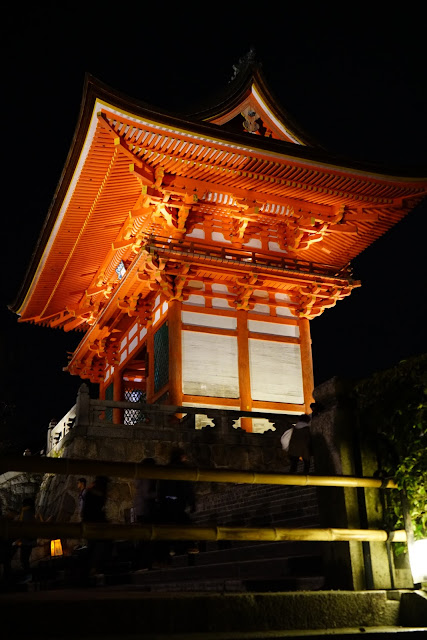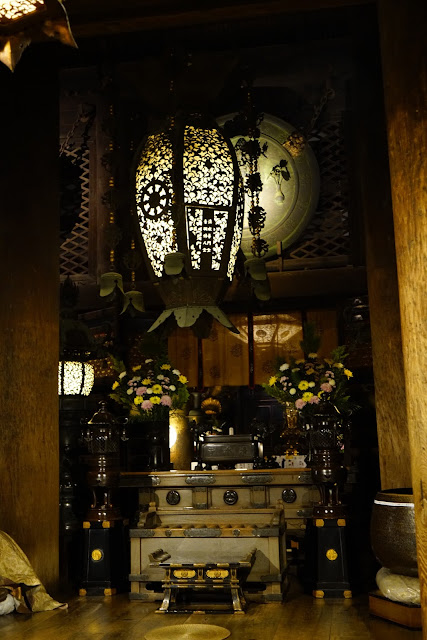It's red leaves time again. Time to budge from my chair and my readings and talks etc.
I took to the skies again and had my last look at Hong Kong.

leaving behind its tower blocks, dotted now on the ground like jig-saw patterns on a carpet
After 4 hours, my first glimpse of Osaka.
My first glimpse of the Kansai Airport.

It's Christmas time!

But after custom clearance, I had to take a "green" train, which I later learned from a returned Japanese base ball coach from Sydney doesn't mean smoke-free train but a train with reserved seats.

and finally emerged at the Central Station of Kyoto.

I took a look at my hotel, just 5 minutes from the railway station.

Close by is a map stand with photos of various places where red leaves could be found.

Time for some grub at the hotel restaurant immediately after depositing my luggage in my room. First some appetizers.
creamy and juicy Japanese lobster.

I could see a bar through the reflections on the window

and wine inside too. But as I had to go out to a temple later that night, no point in walking zig zag in unfamiliar territory.

There's a UNESCO World Heritage site temple to be seen that evening: the
Otowa-san Kiyomizu-dera (音羽山清水寺), in eastern Kyoto, one of the Historic
Monuments of Ancient Kyoto and a UNESCO World Heritage site since 1994. It's a
temple originally founded in 794 CE in the early Heian
period (平安時代) by Master 慈恩大師, the first Japanese disciple of Tang Dynasty Chinese monks 唐僧 but had since been rebuilt a number of times, the latest in 1633.
Using the traditional Chinese technique of interlocking joints, not a
single nail had been used. The temple is named after the clear stream
water flowing down the hill there. Kiyomizu means clear or pure
water(清水). Beneath the main hall is the Otowa waterfall, where three channels of
water fall into a pond. Visitors can catch and drink the water, which is
believed to have wish-granting powers.
The temple was originally owned in the Nara period (奈良時代) or Nara jidai CE 710 to 794. by an influential Buddhist sect called 法相宗 Fǎxiàng-zōng and in Japanese Hossō sect, meaning "Dharma characteristics school" However, in 1965 it severed that affiliation with the Hossō sect ( 法相宗) and now calls itself the "Kitahossō" sect (北法相宗). The original Fǎxiàng-zōng forms part of the Indian Yogācāra sect (瑜伽行派) called Wéishí-zōng (唯識宗) called in Japanese Yuishiki-shū, meaning 'consciousness only school".(唯識宗). The term "Fǎxiàng"( 法相) was first used by the Chinese Huayan School (華嚴宗) master Fazang (法藏) to emphasize that the "consciousness only" (唯識) teaching deals with only the "phenomenal appearances" (相) of the "dharmas" (法) in contrast to Huayan School (華嚴宗), which deals with the "underlying nature" on which such phenomenal appearances or forms (相) were based. However, Chinese proponents preferred the title Wéishí (唯識), meaning "consciousness only" and called "Vijñaptimātra" in Sanskrit. In Chinese Buddhism, Wéishí-zōng (唯識宗 ) is classified as one of the Yǒu Zōngs (有宗) or "School of Existence" because their followers deal with what "appears" to "exist" in the so-called "real everyday world" of the Buddhist followers and of lay people when according to the teachings of Huayan School (華嚴宗), the true nature of what appears "real" in our everyday world is strictly speaking little more than "illusions" and is thus not "truly real" at all. Faxiang school 法相宗) teaches that our understanding of reality comes from our own mind, rather than actual empirical experience. Our mind distorts reality and projects it "as if" it were "true" reality itself. This kind of teaching is like what Bishop Berkeley (1685-1753) (an "Idealist) in Europe taught ie.the human mind cannot access what is really out there in what we normally regard as our external world. All that the human mind is capable of accessing is the movements of the relevant "ideas" circulating inside our own brain, in contrast to the "Realists" like Aristotelians, who think that the "ideas" inside our brain do truly correspond or accurately represent what we perceive as physical objects out there in the external world through our senses. The ideas of the Huayan School (華嚴宗) also correspond to the thoughts of Immanuel Kant (1724-1804), who also argues that human beings can never access the objects out there in the external world directly which remains always mysterious and unknown, something he calls "noumen" . To him, all that human mind is capable of accessing through their brains, is "what appears" to the human mind itself namely the "phenomenon" or the "appearances" of the relevant real objects through the mental framework or categories, concepts created by the human mind itself. Kant posits 12 such mental categories/concepts viz. Quantity(Universal, articular, Singular) Quality ( Affirmative, Negative, Infinite), Relation (Categorical, Hypothetical, Disjunctive) Modality (Problematical, Assertoric, Apodictic). In keeping with Yogacara tradition, to them the mind is divided into the Eight Consciousnesses (八識) and the Four Aspects of Cognition which produce what we view as reality.
The temple was originally owned in the Nara period (奈良時代) or Nara jidai CE 710 to 794. by an influential Buddhist sect called 法相宗 Fǎxiàng-zōng and in Japanese Hossō sect, meaning "Dharma characteristics school" However, in 1965 it severed that affiliation with the Hossō sect ( 法相宗) and now calls itself the "Kitahossō" sect (北法相宗). The original Fǎxiàng-zōng forms part of the Indian Yogācāra sect (瑜伽行派) called Wéishí-zōng (唯識宗) called in Japanese Yuishiki-shū, meaning 'consciousness only school".(唯識宗). The term "Fǎxiàng"( 法相) was first used by the Chinese Huayan School (華嚴宗) master Fazang (法藏) to emphasize that the "consciousness only" (唯識) teaching deals with only the "phenomenal appearances" (相) of the "dharmas" (法) in contrast to Huayan School (華嚴宗), which deals with the "underlying nature" on which such phenomenal appearances or forms (相) were based. However, Chinese proponents preferred the title Wéishí (唯識), meaning "consciousness only" and called "Vijñaptimātra" in Sanskrit. In Chinese Buddhism, Wéishí-zōng (唯識宗 ) is classified as one of the Yǒu Zōngs (有宗) or "School of Existence" because their followers deal with what "appears" to "exist" in the so-called "real everyday world" of the Buddhist followers and of lay people when according to the teachings of Huayan School (華嚴宗), the true nature of what appears "real" in our everyday world is strictly speaking little more than "illusions" and is thus not "truly real" at all. Faxiang school 法相宗) teaches that our understanding of reality comes from our own mind, rather than actual empirical experience. Our mind distorts reality and projects it "as if" it were "true" reality itself. This kind of teaching is like what Bishop Berkeley (1685-1753) (an "Idealist) in Europe taught ie.the human mind cannot access what is really out there in what we normally regard as our external world. All that the human mind is capable of accessing is the movements of the relevant "ideas" circulating inside our own brain, in contrast to the "Realists" like Aristotelians, who think that the "ideas" inside our brain do truly correspond or accurately represent what we perceive as physical objects out there in the external world through our senses. The ideas of the Huayan School (華嚴宗) also correspond to the thoughts of Immanuel Kant (1724-1804), who also argues that human beings can never access the objects out there in the external world directly which remains always mysterious and unknown, something he calls "noumen" . To him, all that human mind is capable of accessing through their brains, is "what appears" to the human mind itself namely the "phenomenon" or the "appearances" of the relevant real objects through the mental framework or categories, concepts created by the human mind itself. Kant posits 12 such mental categories/concepts viz. Quantity(Universal, articular, Singular) Quality ( Affirmative, Negative, Infinite), Relation (Categorical, Hypothetical, Disjunctive) Modality (Problematical, Assertoric, Apodictic). In keeping with Yogacara tradition, to them the mind is divided into the Eight Consciousnesses (八識) and the Four Aspects of Cognition which produce what we view as reality.
It can be seen in the photo that it stands on a gigantic wooden platform. According to internet materials, a total of 139 round-shaped wooden pillars and beams had been used in its construction. Its main hall measures some 19 by 16 meters and has 6 storeys. Large verandahs and huge platforms were quite popular in the Edo period because of huge numbers of Buddhist followers. The platform is so high that there's a saying in Japan in the Edo period (江戸時代) or Tokuagawa Shogunate period ( 徳川幕府時代) (1603-1868) the effect that if one could survive the 13-Meter jump there, then whatever wishes one might have would be granted. According to the records, a total of 234 such jumps had been documented and 85.4% of those who did so survived So the practice is now banned.
On the way up the hill, these paper lanterns could be seen hung on the eaves of many of the small restaurants and shops lining the narrow street.

This one sells Japanese crockery
and this one sells all kinds of Japanese cakes and candies.
The street up was full of visitors, mostly Japanese, either local or from other parts of Japan.

The front of the temple was thronged with eager visitors from all parts of Japan and elsewhere

The front of the temple was thronged with eager visitors from all parts of Japan and elsewhere

The tired looking ticket clerks. They had been working the whole day long because the temple would be open to visitors at night only for about 3 weeks around this time of the year.

At the rear, one sees the famous 3-tiered tower (三重塔)
Lights shining on to some of the Japanese maple leaves

The leaves at the top are beginning to turn yellow.
A closer look
When one climbs higher, one gets a better view
The main hall
The three-tiered tower from another angle
A dark face god
An ancient gong
A latticed lantern.
A wall of wishes
A lonely lady
The viewing gallery supported by 139 wooden pillars
A closer look at the viewing gallery
The viewing galleries are surrounded by maple trees.
All of Kyoto below one's feet.
Another view of the three-tiered tower
A restaurant which is closed for business
The tower behind the trees
Reflections of the trees on a pond
More reflections on the pond, just like my memories of the temple.








































沒有留言:
張貼留言